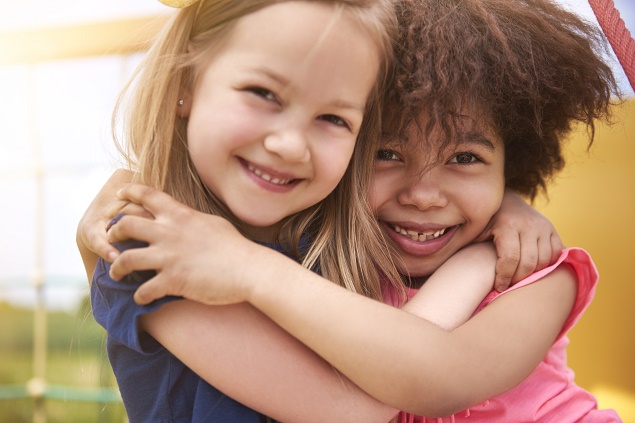Race issues are currently a major topic of national discussion. America has been reawakened to the fact that prejudice does indeed exist and demands attention. This article is for anyone who has relationships with children. Discussing these issues with an anti-bias message can reduce the prejudice that children express internally or to others.
However, this topic seems to create the same feelings in many adults as talking to children about sex. Because it is important for adults to consider children’s ages and developmental stages when discussing this topic, I will provide a brief but informative summary of social-cognitive development in children.
By six months of age, infants are able to non-verbally categorize people by race and gender. Therefore, there are some researchers who suggest that awareness of race may possibly begin even earlier. It is important to understand that racism can appear in children who are as young as five years old.
It is interesting to note that various studies show children’s racial beliefs are not necessarily related to the beliefs of their parents. Children gather their information about race from a number of sources, not just from their families.
Children’s immature cognitive development precludes them to make over-generalizations. They may see people who are alike in skin color and assume that they are alike in all other dimensions such as intelligence, abilities, or temperament. Society teaches children that race is a significant social category. When children live and interact exclusively with people of the same color they may avoid or dislike people of other skin colors.
This are only some of the reasons it is so vitally important to be intentional about guiding our children to healthy conclusions regarding race. But, social structures can often work against racial equity and tends to reinforce the importance of one race over another.
Here in the United States, the white culture is often presented as the norm in terms of appearance, dialect variations of the English language, and cultural practices. Jesus is often depicted with white skin and light hair. At Christmas, Santa is presented as Caucasian.
Parents of color will discuss race with their children more freely than white parents, but all children need to be exposed to anti-bias teaching. The following are ways that all people can give their children a better understanding of a very complex issue.
- Go to God in prayer and ask Him to search you for clues of racism and bias that you might believe or express to others. Think about how you received this message and how you might be led to change.
- Engage your children in honest, open, accurate, and age appropriate conversations regarding race. Research shows that having these conversations actually helps children to prevent stereotyping
- If incidences of racism occur with your child in school or on the playground, take this seriously. If we brush this off, then children might infer that we accept this behavior or do not see it as an issue. Make it clear to children that there is never an acceptable reason for rejecting or teasing someone else. This demands a zero tolerance policy.
- Encourage your children to see the multiple attributes of a person. Talk about the fact that someone is not just their skin color but much more. Highlight their abilities, fruits of the spirit, and other ways God created them uniquely.
- Empower your children to face troubling problems. Teach them how to handle conflicts in appropriate ways.
- Expose your children to books, dolls, toys, paintings, photographs, TV programs, and other mediums that show diverse images of color.
- Notice the exclusivity of the people that you interact with; doctors, friends, and services you engage. Provide hospitality in your home to people of many cultures and races. Children will notice your example.
- Attend community events that are culturally different. This might include museums, concerts, festivals, and even restaurants.
There is neither Jew nor Gentile, neither slave nor free, nor is there male or female, for you are one in Christ Jesus.
Galatians 3:38
Whatever the topic, silence speaks loudly to children. Being actively engaged in talking about and exposing children to racial issues is a major step you can do to decrease prejudice in our society.
Additional Resources
Books for Children:
We’re Different; We’re the Same (Sesame Street) by Bobbi Jane Kates
The Judgmental Flower by Julia Cook
The Other Side by Jacqueline Woodson
The Crayon Box that Talked by Shane DeRolf
Let’s Talk About Race by Julius Lester and Karen Barbour
Books for Adults:
The First R: How Children Learn Race and Racism by Debra Van Ausdale and Joe Feagin
What If All the Kids Are White? by Louise Olsen Derman-Sparks, Patricia G. Ramsey and Julie Olsen Edwards
Why Are All the Black Kids Sitting Together in the Cafeteria: And Other Conversations About Race by Beverly Daniel Tatum
Recovering From Racism: A Guidebook to Beginning Conversations by Stephany Rose
Internet Video Resource for Adults:
How to Overcome Our Biases? Walk boldly toward them.
Works Consulted (for further research)
The Psychology of Prejudice and Discrimination by Bernard E. Whitley and Mary E. Kite
Children Are Not Colorblind: How Young Children Learn Race by Erin Winkler, PH.D, University of Wisconsin Milwaukee
Teaching Young Children to Resist Bias: What Parents Can Do by Louise Derman-Sparks, Maris Gutierrez, Carol Brunson Phillips: National Association of Young Children
Kathy Milans is the lead member of Soul Care Collective’s Steering Committee.



